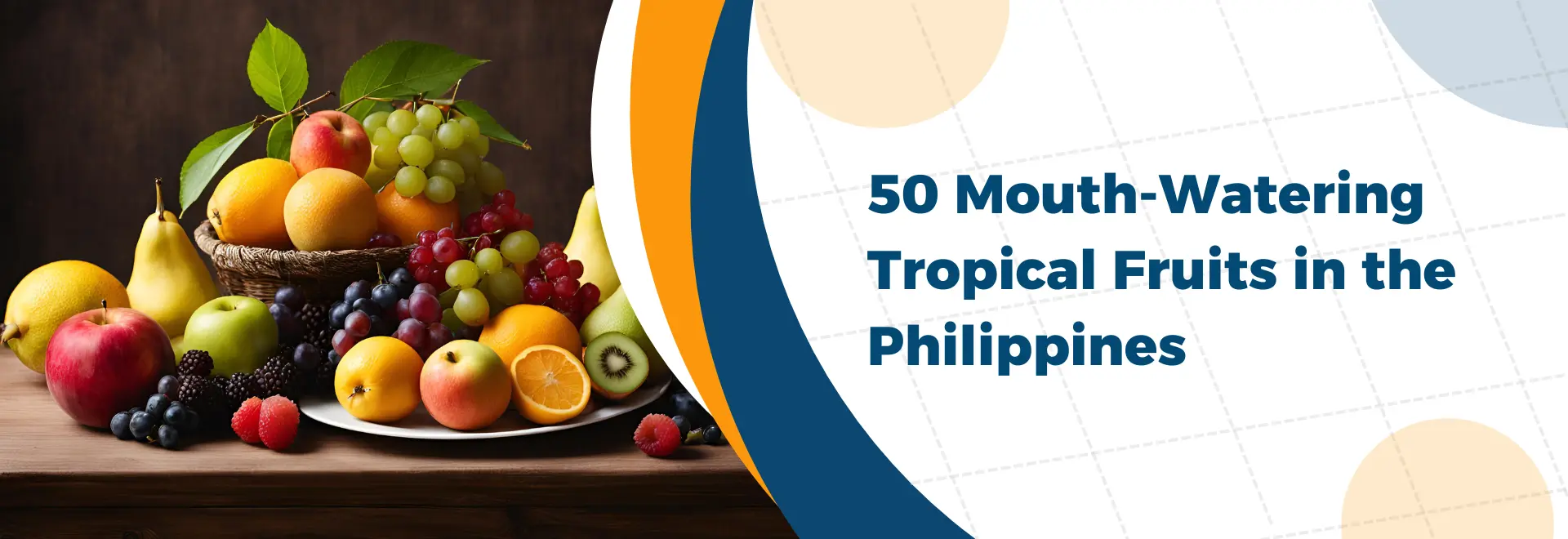
50 Best Mouth-Watering Native and Tropical Fruits to Try in the Philippines
Introduction
Summer has begun and eating delicious tropical fruits from a tropical country makes it more enjoyable and fantastic. The Philippines is one of the many tropical islands in Southeast Asia. It has many exotic fruits that can make you feel refreshed and want more. Visiting the Philippines is a good choice, especially on vacations as it is a humble haven to many tropical fruits.
Aside from the beautiful beaches and hospitable people, it also offers a variety of tropical fruits worth savoring. Thus, upon visiting Cebu, you might see lots of delicious fruits around. This country is known as a tropical paradise and it is a good place to unwind during summer vacations. Below are some 50 juicy and delicious tropical fruits to try.
Moreover, some tropical fruits here become delicacies in some provinces and even as a source of the town’s festivals. People celebrate and dance with the use of fruits, which will be revealed later on. Usually, Filipinos love to pair some fruits with salt, especially sour ones. Below are some juicy and delicious fruits to try in the Philippines.
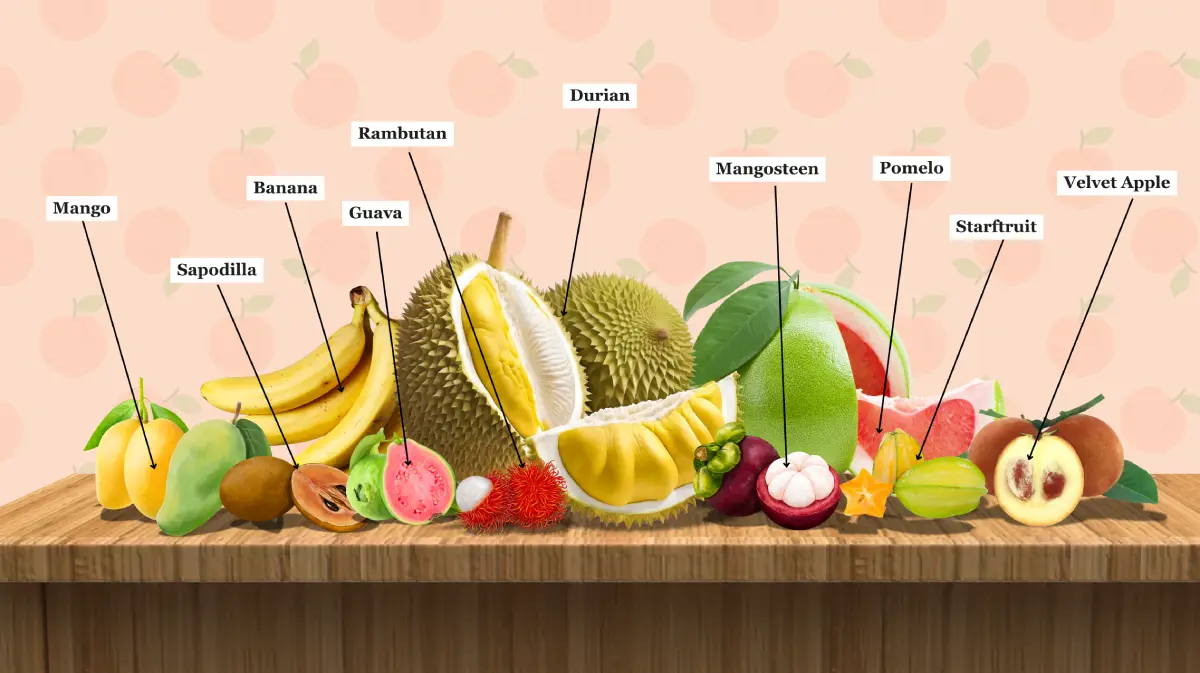
10 Best Delicious Tropical Fruits to Try in the Philippines
- Mango
Scientific Name: Mangifera indica
Cebuano Name: Mangga
Bearing Season: March to June
Carabao Mangoes are very popular in the Philippines. It is also considered as the national fruit of the country. This tropical fruit is known for its sweet and delicate flavor with lots of vitamin C. It can be used as desserts like mango grahams, iced candy, mango pies, and so on. Moreover, in the Philippines, there are four kinds of mangoes: Carabao mango, Indian mango, and Pico mango.
Filipinos love to eat Indian mangoes that are not ripe yet. These tropical fruits are sour yet delicious, especially when paired with a shrimp paste (hipon) or salt. It can also be paired with soy sauce and sugar (patis and kamay). However, this method does not apply to ripped mangoes, it is only for the green ones.
- Guava
Scientific Name: Psidium guajava
Cebuano Name: Bayabas
Bearing Season: September to December
Guavas have a rough green texture outside but are soft and fleshy inside. When ripened their rough texture will become light or yellowish-green and easier to bite. It is very delicious and even the seeds are digestible. It is also good when paired with salt and chili. This tropical fruit has more Vitamin C compared to oranges. It has many uses as well, such as making tea and treatment. In the Philippines, guava leaves can be used as tea to cure sick people.
- Durian
Scientific Name: Durio zibethinus L.
Cebuano Name: Duryan
Bearing Season: July to October
Durians typically grow in Southeast Asian countries, considered the “King of Fruits.” It has its hard spikes and delicious taste. It has a strong smell, but its flavor is pleasant to taste. It has lots of nutrients, which are good for our bodies. In Davao City, approximately 80% of Durian production is found in mountainous areas of this place as it has a tropical climate.
- Sapodilla
Scientific Name: Manilkara zapota
Cebuano Name: Chikoos
Bearing Season: January – February
Chicos also known as Sapodillas are called Chikoos in the Philippines. It has a soft, juicy, and grainy texture. It is a round-colored brown sweet tropical fruit and has been noted to be high in natural sugar, which is organic. Thus, it presents many health benefits and is good for desserts, too. Moreover, this tropical fruit is also commonly found in Southeast Asian countries.
- Mangosteen
Scientific Name: Garcinia mangostana
Cebuano Name: Manggostin
Bearing Season: August to September
Mangosteen has a tart-sweet and sour taste. This tropical fruit can be seen as a round purple fruit, similar to a tennis ball with fluffy white flesh inside. They have big seeds, so it’s best to sip and gnaw them until they are bland. It has an addicting taste, so it is best not to swallow the whole wedges because the seeds can choke you.
- Rambutan
Scientific Name: Nephelium lappaceum
Cebuano Name: Rambutan
Bearing Season: August to October
Rambutans come from the same family as lychee, but it has the same texture. They are known for their hairy red but often yellowish skin. This sweet and savory tropical fruit is also native to Southeast Asian countries, including the Philippines, but is unsuitable to grow in all regions. They have white flesh and big seeds on the inside. So, it’s best not to chew them, too. The word “Rambut” is a Malay word for “hair.” This fruit is also abundant in potassium which is good for our heart.
- Star Fruit
Scientific Name: Averrhoa carambola
Cebuano Name: Balimbing
Bearing Season: August to October
This delicious tropical fruit is known for its star-shaped texture. It comes in a yellow or green color with a little tangy sour but sweet flavor. They can also be paired with salads and cocktails to add design and attractiveness to the dish or drinks. This juicy one usually tastes like a combination of grapes, oranges, and pears.
- Pomelo
Scientific Name: Citrus maxima
Cebuano Name: Buongon
Bearing Season: November to January
Pomelo is a kind of citrus fruit that is native to Asian countries. It is also considered the biggest Citrus in its family. They are usually called as big sweet oranges but are not watery. They have green skin and a thick white layer that tastes bitter. Filipinos love to eat this fruit with salt to add more texture to its flavor. This delicious fruit is full of minerals, vitamins, and antioxidants, especially since it is low in calories.
- Banana
Scientific Name: Musa
Cebuano Name: Saging
Bearing Season: Any time of the year
Bananas are known for their yellow skin and white elongated flesh. However, in the Philippines, there is more to that, they vary in size and appearance, too. This country is popular for its banana cultivation and production. There are 12 types of bananas, that can be found in the Philippines. Each of these types has different purposes as well. This delicious fruit is very flexible in some ways. It can be used for ketchup and chips; dishes like humba —a pork dish with a sweet-like flavor; desserts like salad, halo-halo, and shakes; for snacks like banana cue, pinaypay — a fan-shaped long slices of banana with sugar.
- Velvet Apple
Scientific Name: Diospyros blancoi
Cebuano Name: Mabolo
Bearing Season: Any time of the year
The velvet apple is one of the exotic fruits in the Philippines and is also native to Taiwan. It is commonly found in tropical regions. This custard-like delicious fruit is known for its strong aroma. Its color varies in a reddish brown velvet texture and its flesh is white to yellow. The size is similar to apples but it has a different taste and has tiny hairy-like skin. This one has a combination of apple and banana flavors.
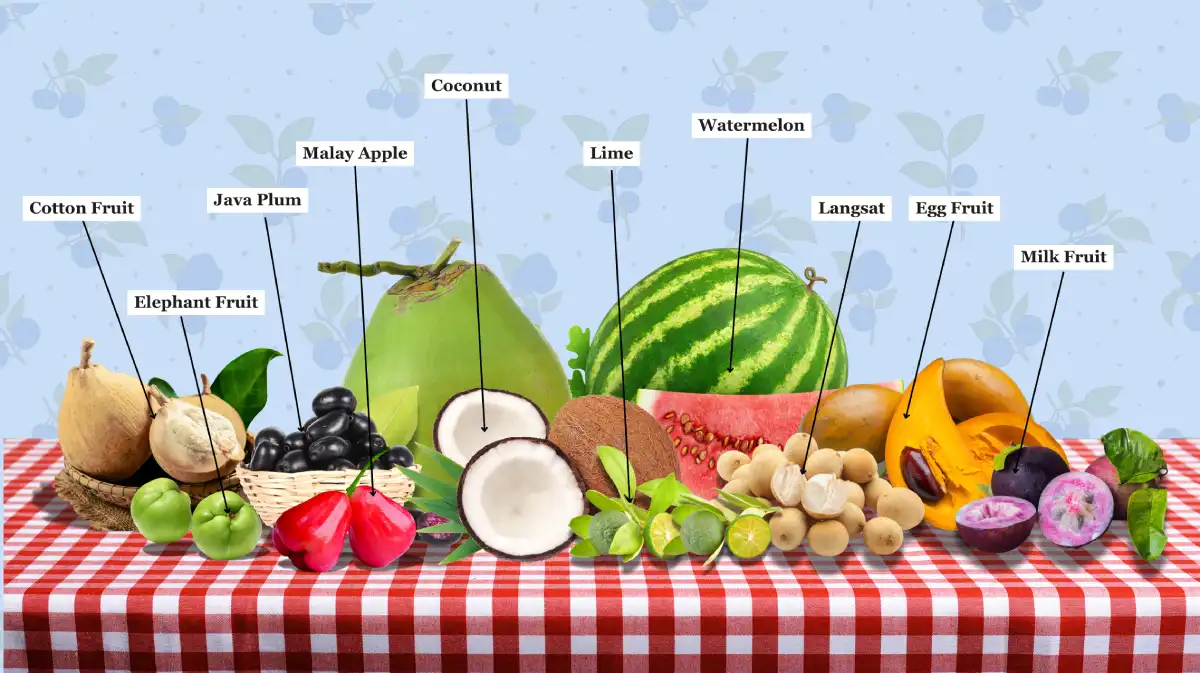
10 Sour and Unique Tropical Fruits in the Philippines
- Watermelon
Scientific Name: Citrullus lanatus
Cebuano Name: Watermelon
Bearing Season: March to June
Watermelons are one of the most popular tropical fruits to eat due to their watery texture. This delicious fruit is round with dark and light green stripes, which is noticeable since it is the only fruit that has it. They have red soft, sweet, and granular flesh inside, but when overripe, it will harden. They are refreshing to drink, as well, especially on summer vacation. You can eat watermelon fresh, shake or drink it, or frozen like a popsicle ice cream.
- Elephant Apple
Scientific Name: Dillenia indica
Cebuano Name: Katmon
Bearing Season: October to January
Katmon is one of the rarest tropical fruits in the world. It is usually native to India but also grows here in the Philippines. This fruit originated from the Dilleniaceae family tree and grows on tall green trees 15 meters above. This tree is common in Luzon, Leyte, Negros, Guimaras, Cebu, and some areas in the Philippines. This delicious fruit can usually be used in culinary ingredients, like sinigang, and is now considered endangered.
There is a place in Cebu, called Catmon, from which this name was derived. Although this fruit is not commercially introduced due to its limited numbers, it is still one of the foods to try. Especially in Catmon, Cebu. It has a grape-like and very sweet-sour taste when ripened. It looks like a sleeping elephant’s head that has formed into a circle and inside has a swirl-like green pulp.
- Malay Apple
Scientific Name: Syzygium malaccense
Cebuano Name: Makopa
Bearing Season: February to June
Malay Apple is among the most delicious fruits in the Philippines. It looks like an upside-down dark red tulip flower but with the taste of an apple. They share the same taste as apples but are softer. In comparison to apples, they are denser and sometimes bland.
- Egg Fruit
Scientific Name: Pouteria campechiana
Cebuano Name: Tisa
Bearing Season: February to June
This delicious fruit is known for its round to oblong yellowish shape. They also have waxy skin and a sweet taste. It is like a combination of pumpkin, papaya, sweet potato, and mango. Its color is derived from the yolk of an egg, which is a golden yellow color, but it does not taste like an egg. It comes from the Sapote family, and its pulp and skin can be used as antioxidants.
- Langsat
Scientific Name: Lansium domesticum
Cebuano Name: Lansones
Bearing Season: August to September
This delicious fruit comes from the Meliaceae family tree with a sweet flavor. This is native to Southeast Asian countries, particularly, Thailand, Indonesia, Malaysia, and the Philippines. They are small and their wedges are divided into 5-6 slices with their seeds inside of it. Others would say, it takes like a sweet pomelo. However, even though it is edible, you must not swallow the whole slice since its seeds are bitter.
- Philippine Lime
Scientific Name: Citrus × microcarpa
Cebuano Name: Lemonsito
Bearing Season: August to October
Calamansi are also considered as Philippine Limes which come from a citrus family. They are small round green fruits and it is perfect for drinks. This small fruit is flexible as it can be used in different ways. It has a sour flavor which can be used as a beverage, cake, sauce, or even for culinary purposes to add a soury texture such as noodle dishes —bam-i, and pancit. To make a drink with this fruit, just cut it in half, get its dew, and add sugar, depending on your taste.
- Java Plum
Scientific Name: Syzygium cumini Myrtales
Cebuano Name: Lumboy
Bearing Season: May to June
This delicious fruit is often mistaken as pure violet, but its color is more deep blue or velvety pink. They are small —around 1-2 centimeters in length— and it is also not best to swallow them because they have seeds. Although not big seeds, it is best to be safe. When you eat this, your tongue will turn blue-violet due to its dye color. Filipinos love to eat this delicious fruit a lot. It has a sour taste and is watery with no fats.
- Cotton Fruit
Scientific Name: Sandoricum koetjape
Cebuano Name: Santol
Bearing Season: July to September
One of the most sour and sweet but delicious fruits in the Philippines. This fruit has a thick light brown peel and a bitter taste. It also helps in minimizing bad cholesterol. In the Philippines, it is best to eat this fruit with salt to add texture to its flavor. It is also a good way to combat the sour flavor. Moreover, it has a pillow-like white pulp similar to cotton that is put together. Their flesh also has a sweet, tangy, and tart candy-like taste.
- Coconut
Scientific Name: Cocos nucifera (L.)
Cebuano Name: Lubi or Butong
Bearing Season: Any time of the year
This delicious fruit is very famous in any tropical region. You can drink the water raw just like juice. Many people would love to eat their white flesh, especially with condensed and evaporated milk. In some family gatherings, this drink is present, especially if you live near mountainous areas. This palm fruit is very flexible and can be used in many ways. Their waters can be used as vinegar and wines called tuba. The coconut milk can be used to add flavor to some dishes like ginataang utan (vegetable in coconut milk soup). It can also be used to make delicacies like rice cakes —bibingka, budbud kabog, and biko.
- Milk Fruit
Scientific Name: Chrysophyllum Cainito
Cebuano Name: Kaymito
Bearing Season: December to April
Milk fruit is also known as a star apple due to its star-shaped pattern formed by the seeds inside when sliced. They are usually colored purple when ripe. This delicious fruit has a chewy jelly-like and milky flesh which is perfect for fruit salad. It has a sweet taste with a hint of grapes and milky melon combined.
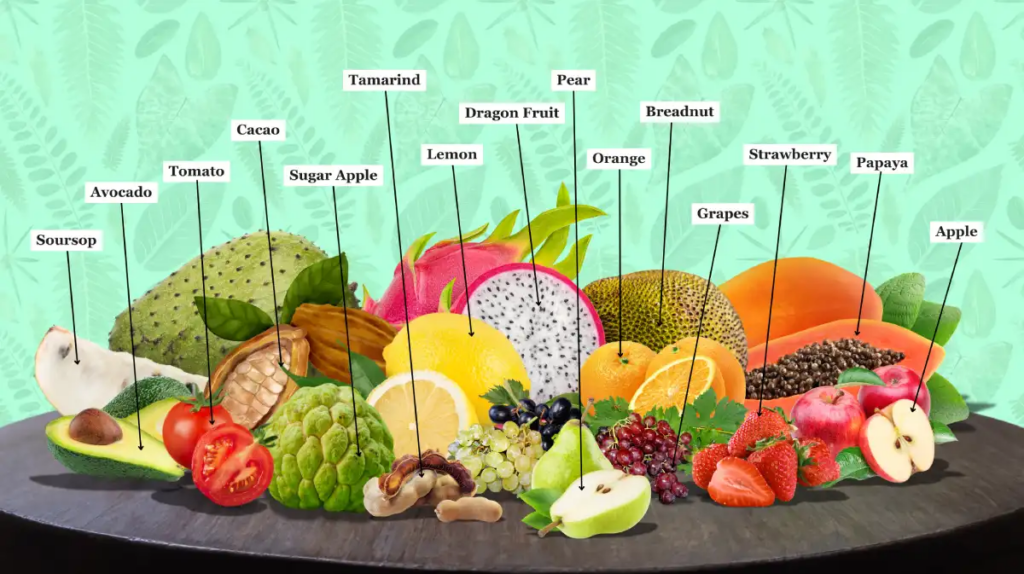
30 More Savory Tropical Fruits in the Philippines
Below are some tropical fruits that can be found in the Philippines. Some of these are not commercially available to the market but Filipino people love to eat these at home, especially ones that come from big trees.
- Sabana (Soursop)
- Abokado (Avocado)
- Kamatis (Tomato)
- Kakaw (Cacao)
- Atis (Sugar Apple)
- Sambag (Tamarind)
- Limon (Lemon)
- Pitaya (Dragon Fruit)
- Peras (Pear)
- Orange (Orange)
- Kamansilis (Breadnut)
- Ubas (Grapes)
- Stroberi (Strawberry)
- Kapayas (Papaya)
- Mansanas (Apple)
- Anonas (Anonas)
- Tambis (Watery Rose Apple)
- Pasyon (Passion Fruit)
- Marang (Marang)
- Siniguelas (Spanish Plum)
- Melon (Melon)
- Ponkan (Tangerine)
- Manzanitas (Jamaican Cherry)
- Pinya (Pineapple)
- Kulo (Breadfruit)
- Granada (Pomegranate)
- Mais (Corn)
- Nangka (Jackfruit)
- Long-an (Longan)
- Kiwi (Kiwi)
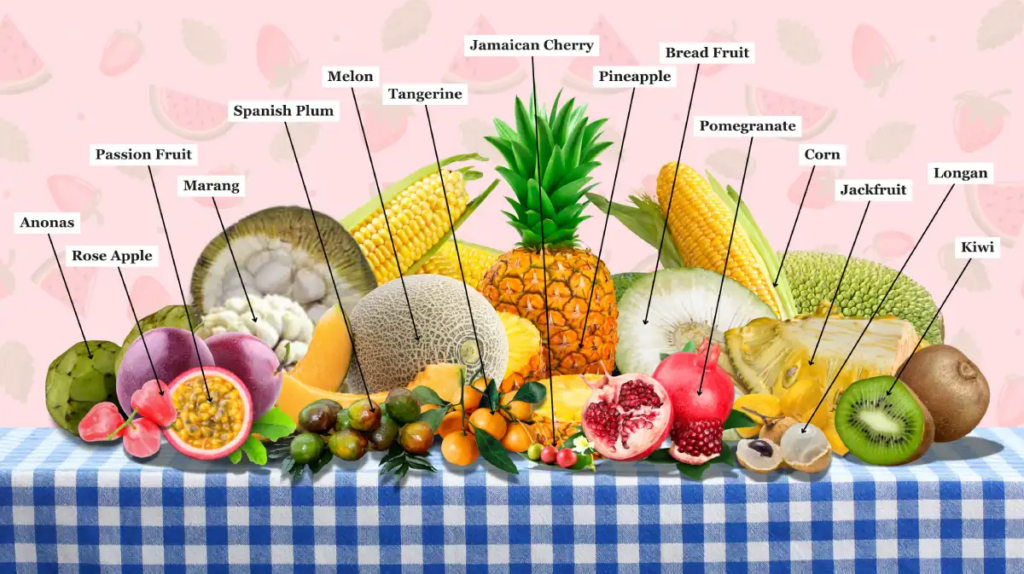
Key Takeaway
When visiting the Philippines, especially enrolling in QQEnglish campuses —IT Park and Beachfront— it is best to try some delicious fruits. It can satisfy your fruit cravings, particularly here in Cebu, Philippines. It has a lot of fruits that can make your mouth watery and hungry. With all of these, always remember, that Filipinos love to eat fruits with either salt, shrimp paste, sugar, or even vinegar. Moreover, it is better to know their customs and traditions as well. Therefore, do not forget to have them as well. Enjoy your staycation in the Philippines!




